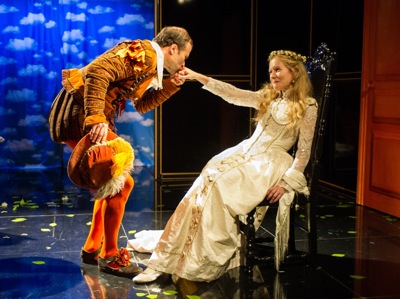
As part of its Spanish Golden Age season that lasts until the Ides of March the Arcola Theatre in Dalston is presenting three plays from what it calls ‘the last unopened treasure-chest of world drama.’ We’re in Baroque Madrid, Don Quixote is in all the best libraries, Velazquez could pop in at any moment to finish a portrait and the Inquisition might burst in at night and cart you off to prison. Spain is in its Golden Age and Don Gil is in his green breeches. Written by Tirso de Molina in 1615, Don Gil de las Calzas Verdes (Don Gil of the Green Breeches) was part of the flourishing of art and literature in Hapsburg Spain.

Don Gil Of The Green Breeches. Photo: Jane Hobson
The costumes by Mark Bailey take us back to de Molina’s Madrid. Katie Lightfoot as Donna Ines sports a bustled dress, whilst Simon Scardifield plays a delightfully morose Don Juan in orange tights, paned hose and a much readjusted flowery garter. The set makes less attempt to transport us. The backdrop is a sheet of cumulonimbus inspired graphics and a solid yellow ladder leading up to a balcony from which characters comment on the action below.
If you enjoy Shakespeare’s girl disguised as boy plot lines then this is for you. Even at the start there’s no messing around with anything so dull as a girl dressed as a girl. Act One, Scene One when we first see Donna Juana – played with gusto by Hedydd Dylan – she is already dressed as a man in green velvet. This means that she has to explain to us quite a lot of who, when, why, where and what. We also don’t get to see her relationship with Don Martin, the breakdown in which is the cause of the play’s deceptions. All the way through there are similar long recaps of the latest events, Donna Ines giving a particularly amusing monologue that becomes so breathless and incomprehensible that we realise that the director, Mehmet Ergen understands that the plot machinations are not to be taken seriously.
All farces take time to set up the internal world before the hilarity can burst out, but Don Gil takes longer than most. When it gets there there is a period of mad dashing, wooing, duelling and disguising, but the build up is slow, and one of the biggest laughs in the first half comes not from the plot or witty repartee, but when a character anachronistically mentions Harry Hill.
The script is from a new translation by Sean O’Brien and has an attractive rhythm. The Somerset Maugham Award winning poet is of course stuck with de Molina’s original plot which majors too much in a lot of people called Don Something pretending to be Don Gil. Romantic comedy is still popular four hundred after this play was written and the cast put great energy into the examination of the roles and behaviours of the sexes. However they are hampered by an underlying plot that lacks the humour of a top-class farce.
The other plays being show as part of the Spanish Golden Age series are A Lady of Little Sense and Punishment without Revenge, both by da Molina’s more famous friend Lope de Vega. Together the three pieces form an introduction to an age of theatre that is little known in England. John Nicholls has created the Spanish-influenced music, and by the wonders of modern technology you can listen to it here.

Leave a Reply